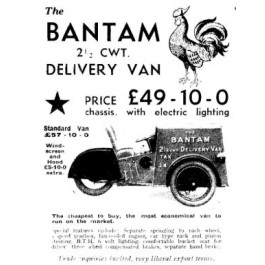The Vincent motorcycle company was founded in the late 1920s by Phil Vincent and it was in 1932 that their first 3-wheeler, “The Vincent Bantam” was first introduced. Powered by a 293cc SV JAP engine (later to be replaced by a 250cc Villiers engine) the vehicle was a 2.5 cwt delivery van which unusually used a car type seat and steering wheel rather than a motorcycle saddle and handlebars favoured by some 3-wheelers produced by motorcycle manufacturers. The standard van was priced at £57-10- 0 though for a extra £5-10- 0 a windscreen and hood could be purchased. Production of the Bantam ceased in the mid 1930s.
In 1954 / 1955 in Stevenage. (UK) a one off prototype Vincent 3-wheeler was produced. The vehicle was powered by a Vincent Rapide 998cc engine and was unofficially named “Polyphemus*” by its previous owner Roy Harper. Before this the vehicle had the name “Locomotion. The names were as a result of the single large cooling opening in the nose panel. This duct ran from the orifice at the front of the body, directly onto the front cylinder of the engine. Additional vents at the side of the Vincent helped cool down the engine further.
In addition to the engine it used a great deal of Vincent motorcycle parts including clutch, power transmission, gearbox and monoshock rear suspension system from their Series D model. The 14” wheels came from a Morris Minor. The two seater body was made of 16 gauge aluminium panels that were bolted onto a 4-inch steel tubed chassis. The tail section of the car was hinged to allow good access to the rear wheel and engine whilst another panel had to be removed to reach the kick starter.
With the standard Rapide engine the Vincent could reach 90 mph. In 1955 this was replaced with a Vincent Black Lightning engine that on its first test propelled the vehicle at a recorded 117 mph, a speed that beat sport MG’s of the same era. It’s perhaps interesting to note that in 1950 a supercharged Black Lightning motorcycle was going to attempt to break the World Speed Record at over 200 mph but despite the bike being built, the attempt was never made.
After several prototypes the Vincent 3-wheeler was offered to the public in 1955 at £500. Despite the interest the price put many people off as the Vincent was not a practical vehicle having no self starter, reverse gear or hood. The whole project therefore was allowed to die a “natural death”.
At least one prototype still exist in the U.K and is owned by top Vincent expert, Bob Culver.
* In Greek Legend Polyphemus was the son of Poseidon and Thoosa and was a Cyclops. (In Greek “Kuklops” meaning “round eye”)





